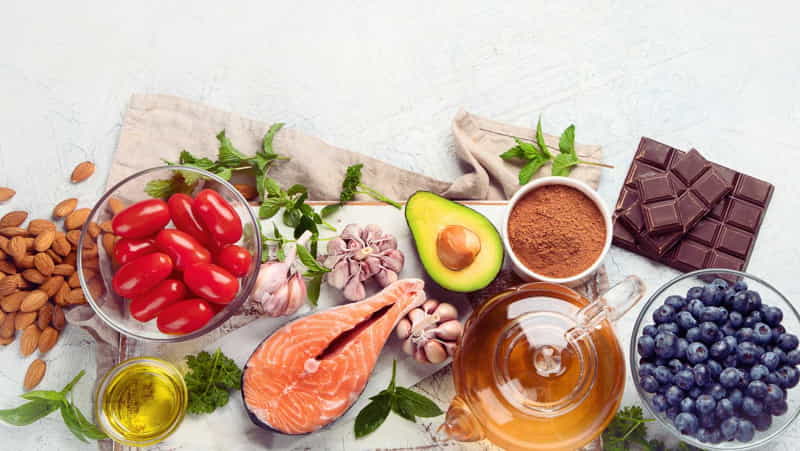
19 Aug Anti-Inflammatory Diet Plan and Food List from a NYC Nutritionist
Online Nutrition Therapy from a New York Dietitian
Diet and nutrition are your first lines of defense to reduce, and even reverse, chronic inflammation. With support from a functional nutritionist, you can manage your chronic conditions, reach a healthy weight (and sustain it!), and start to feel better again. We work to empower our patients to make the best nutrition choices for their unique needs. There is no one-size-fits-all plan for inflammation.
What is inflammation?
Inflammation is your body’s natural defense response to injury, illness, or infection—it’s how healing begins. In a healthy situation, this response is short-term and helpful. But when inflammation becomes long-lasting, or chronic, it can do more harm than good. Chronic inflammation means your body stays in a constant state of alert, releasing inflammatory chemicals for months or even years.
What health problems and disease states are associated with chronic inflammation?
Heart disease and cardiovascular problems
Pre-diabetes and Type 2 diabetes
Obesity and Metabolic syndrome
Colon and liver cancer
Alzheimer’s disease
Autoimmune disorders like rheumatoid arthritis and lupus
Asthma
Depression and mood disorders
IBD (inflammatory bowl disease like Crohn’s and ulcerative colitis)
CKD
Psoriasis and other skin conditions
When your body experiences systemic inflammation, it can affect, well, everything. Gut health, depression, autoimmune disorders, weight gain, and more are all linked to inflammation. Fortunately, nutrition is a first line of defense against inflammation, and by working with a dietitian nutritionist and getting medical nutrition therapy and counseling, you can learn to not only manage your inflammation but also reduce it.
Anti-Inflammatory Food List
Here’s the thing. It’s not as simple as eating a list of foods and voila! It’s a combination of implementing healthy eating habits and patterns along with sustainable lifestyle changes.
We know. It would be so much easier if you could take home a list of groceries and be done with it. But inflammation is a bit more complex than that. Stress, poor sleep quality, smoking and excessive alcohol use, environmental toxins, unresolved infections, obesity, autoimmune disorders, dysbiosis are all factors that contribute to inflammation. So treatment must go beyond a simple shopping list.
As dietitians, education is a key part of nutrition therapy. Instead of focusing on single foods (eating a cup of blueberries won’t change inflammation), it’s important to eat a diverse range of fruits, vegetables, whole grains, healthy fats, and lean proteins. Yes, blueberries, turmeric, green tea, and olive oil have anti-inflammatory effects. But a diet plan requires more variety, more balance, and more of the good stuff.
NYC Holistic Dietitian – Anti-Inflammatory Diet Plan for Beginners
Can diet improve inflammation?
Absolutely!
Keep it simple. We believe everyone should enjoy their favorite foods and family traditions. It’s all about modification and moderation. If you start making extreme changes, it will be harder to implement them and sustain them over time. As dietitians, we meet clients where they are to help them incorporate healthy habits seamlessly.
Get Five Portions of Fruits and Vegetables
- Add berries or cut-up fruit to your morning cereal.
- Rethink soups and pasta sauces. Put broccoli and cauliflower in a blender, cook pumpkin, shred zucchini, and add these veggies to your regular recipes!
- Buy frozen. Frozen fruits and vegetables have as many nutrients as fresh, and it can give you more variety year ‘round.
- Go for color. Make a salad with romaine lettuce and arugula, adding chopped purple cabbage, mangoes or apples, shredded carrots, cherry tomatoes, and sliced radishes. Go for pretty. Pretty (when it comes to veggies) means variety!
Focus on Whole Grains
- Replace rice with quinoa.
- Buy whole wheat breads (the heavier the healthier)
- Try oat flour instead of white flour for muffins, cookies, and cakes.
- Replace crackers with homemade sweet potato chips and pita chips
Have a Diet with Fiber-Rich Foods
- Start the day with oats – opt for steel-cut or rolled oats over instant.
- Add a tablespoon of chia or flaxseeds to smoothies, yogurt, or oatmeal.
- Snack on raw veggies like carrots, celery, bell peppers, or snap peas.
- Include beans or lentils in soups, stews, salads, or wraps 2–3 times a week.
- Swap meat for chickpeas or black beans in tacos, burgers, or curries.
- Keep fruit with the skin on (like apples, pears, plums) for extra fiber.
- Toss a handful of leafy greens (spinach, kale, arugula) into omelets, pasta, or rice bowls.
- Use high-fiber crackers or popcorn as snacks instead of chips or cookies.
- Add avocado to toast, salads, or grain bowls for fiber and healthy fats.
Reduce Foods that Contribute to Inflammation
- Cut out ultra-processed foods
- Lower your sugar intake (replace soda with water with slices of lemon, cut down on sugar bit-by-bit in your morning coffee).
- Lower your alcohol intake.
- Avoid or limit consumption of processed meats.
Implement Mindful Eating Habits
- Turn off your computer, phone, and TV during meals.
- Sit down and eat. Pay attention to the textures, flavors, and colors on your plate.
- Prioritize family meals. Sit together and share your day’s stories and events.
- Take the time to nourish your body.
Diet is your first line of defense when it comes to wellness, reducing inflammation, and managing chronic conditions. With your dietitian, together we can develop an anti-inflammatory diet plan that fits your needs, budget, and includes your favorite foods and flavors.
Start healing your body today.



